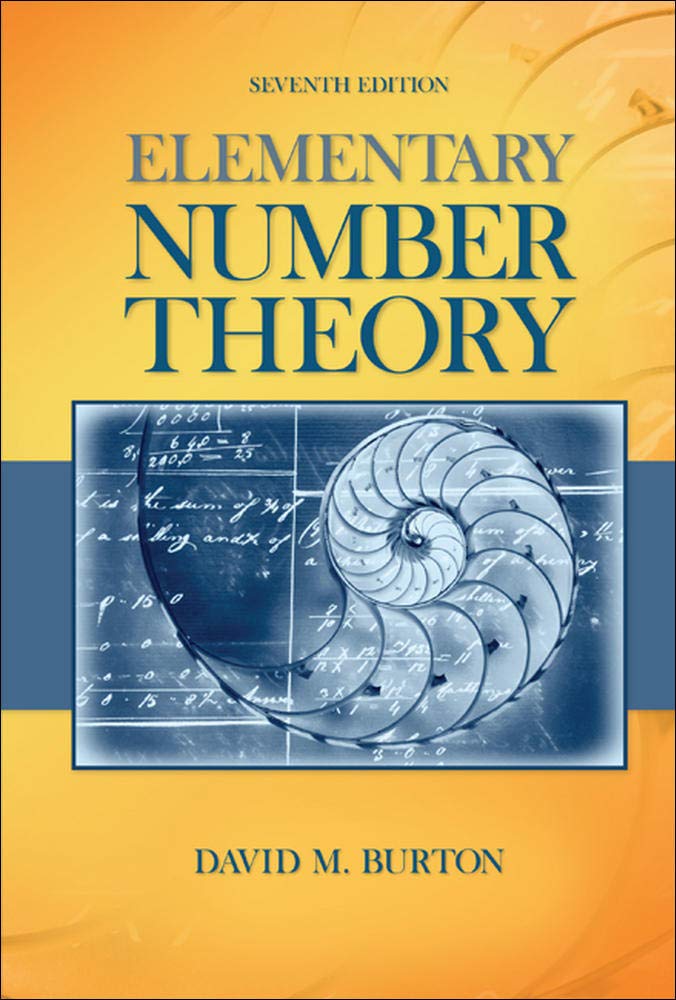
Elementary Number Theory Problems 4.3 Solution (David M. Burton's 7th Edition) - Q2
My solution for "Prove the following statements: (a) For any integer $a$, the units digit of $a^{2}$ is $0, 1, 4, 5, 6,$ or $9$. (b) Any one of the integers $0, 1, 2, 3, 4, 5, 6, 7, 8, 9$ can occur as the units digit of $a^{3}$. (c) For any integer $a$, the units digit of $a^{4}$ is $0, 1, ...$ "
Table of Contents
Background
All theorems, corollaries, and definitions listed in the book's order:

I will only use theorems or facts that are proved before this question. So, you will not see that I quote theorems or facts from the later chapters.
Question
Prove the following statements:
(a) For any integer $a$, the units digit of $a^{2}$ is $0, 1, 4, 5, 6,$ or $9$.
(b) Any one of the integers $0, 1, 2, 3, 4, 5, 6, 7, 8, 9$ can occur as the units digit of $a^{3}$.
(c) For any integer $a$, the units digit of $a^{4}$ is $0, 1, 5,$ or $6$.
(d) The units digit of a triangular number is $0, 1, 3, 5, 6,$ or $8$.
Solution
(a)
We can write $a = q_{m}10^{m} + q_{m - 1}10^{m - 1} + \cdots + q_{1}10 + q_{0}$ where $q_{k}$ can be $0, 1, 2, ...$, or $9$. We then have $a \equiv q_{0} \pmod {10}$, which implies that $a^{2} \equiv q_{0}^{2} \pmod {10}$.
The unit digit of $a^{2}$ is equal to the result of $a^{2} \pmod {10}$, which is congruent to ${q_{0}}^{2} \pmod {10}$ from above.
Therefore, as the possible $q_{0}$ is $0, 1, 2, ...$, or $9$, the possible $q_{0}^{2}$ will be $0, 1, 4, 9, 16, 25, 36, 49, 64,$ or $81$. Thus $\text{(units digit of $a^{2}$)} = {q_{0}}^{2} \pmod {10} = 0, 1, 4, 5, 6,$ or $9$.
Read More: All My Solutions for This Book
(b)
First, we write $a = q_{m}10^{m} + q_{m - 1}10^{m - 1} + \cdots + q_{1}10 + q_{0}$ where $q_{k}$ can be $0, 1, 2, ...$, or $9$.
We know that $\text{(the units digit of $a^{3}$)} = (a^{3} \pmod {10})$. Since $a \equiv q_{0} \pmod {10}$, from Thoerem 4.2 (f), we have $a^{3} \equiv q_{0}^{3} \pmod {10}$.
The possible $q_{0}$ is $0, 1, 2, 3, 4, 5, 6, 7, 8$, or $9$.
Thus the possible $q_{0}^{3}$ will be $0, 1, 8, 27, 64, 125, 216, 343, 512,$ or $729$.
As we can see here, one of the integers $0, 1, 2, 3, 4, 5, 6, 7, 8, 9$ can occur in $q_{0}^{3} \pmod {10}$, which is the units digit of $a^{3}$.
(c)
From above, we have $\text{(units digit of $a^{4}$)} = (a^{4} \pmod {10})$, and $a^{4} \equiv q_{0}^{4} \pmod {10}$.
Also, we have:
$q_{0} = 0, 1, 2, 3, 4, 5, 6, 7, 8$, or $9$.
$q_{0}^{4} = 0, 1, 16, 81, 256, 625, 1296, 2401, 4096,$ or $6561$.
Thus, for any integer $a$, the units digit of $a^{4}$ is $0, 1, 5,$ or $6$.
(d)
Let $T_{n}$ be the $nth$ triangular number. We know $T_{n} = \frac{n(n + 1)}{2}$.
If $n$ is even, we can write $n = 2k$ for some integer $k$. We then have $T_{n} = \frac{2k(2k + 1)}{2} = k(2k + 1)$. As $k \equiv 0, 1, 2, ...,$ or $9 \pmod {10}$, $k(k + 1) \equiv 0, 3, 0, 1, 6, 5, 8, 5, 6,$ or $1 \pmod {10}$. Thus $T_{n} \equiv 0, 1, 3, 5, 6,$ or $8 \pmod {10}$ when $n$ is even.
If $n$ is odd, we can write $n = 2k + 1$ for some integer $k$. We then have $T_{n} = \frac{(2k + 1)(2k + 2)}{2} = (2k + 1)(k + 1)$. As $k \equiv 0, 1, 2, ...,$ or $9 \pmod {10}$, $(2k + 1)(k + 1) \equiv 1, 6, 5, 8, 5, 6, 1, 0, 3,$ or $0 \pmod {10}$. Thus $T_{n} \equiv 0, 1, 3, 5, 6,$ or $8 \pmod {10}$ when $n$ is odd.
Therefore, the units digit of a triangular number is $0, 1, 3, 5, 6,$ or $8$.
Read More: All My Solutions for This Book
Related Pages
Ranblog Newsletter
Join the newsletter to receive the latest updates in your inbox.


